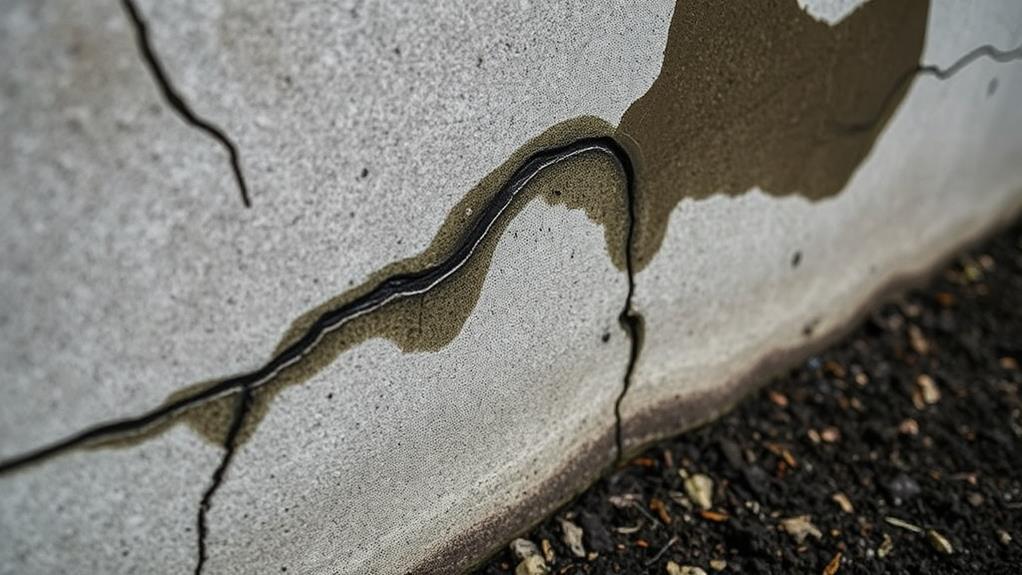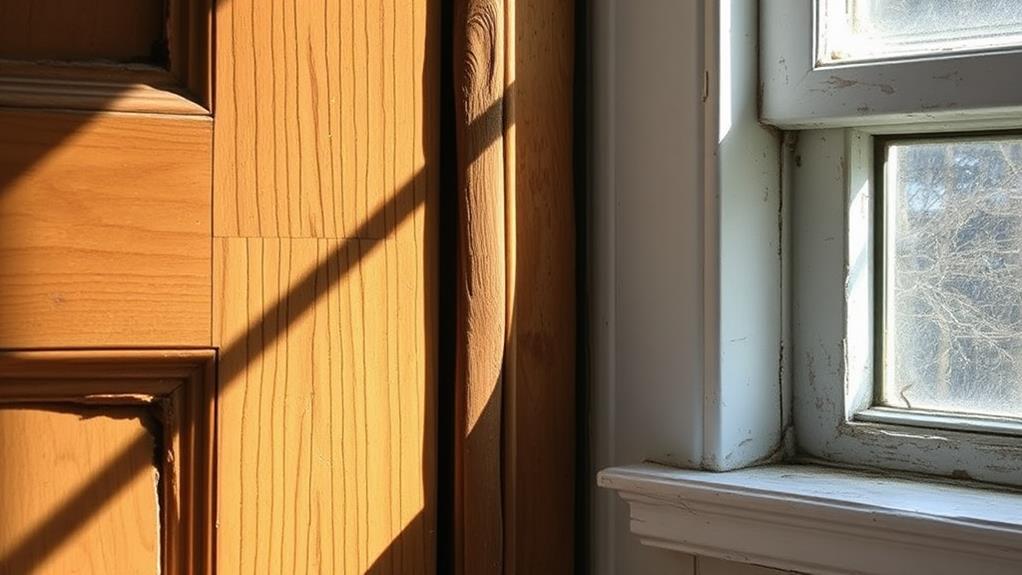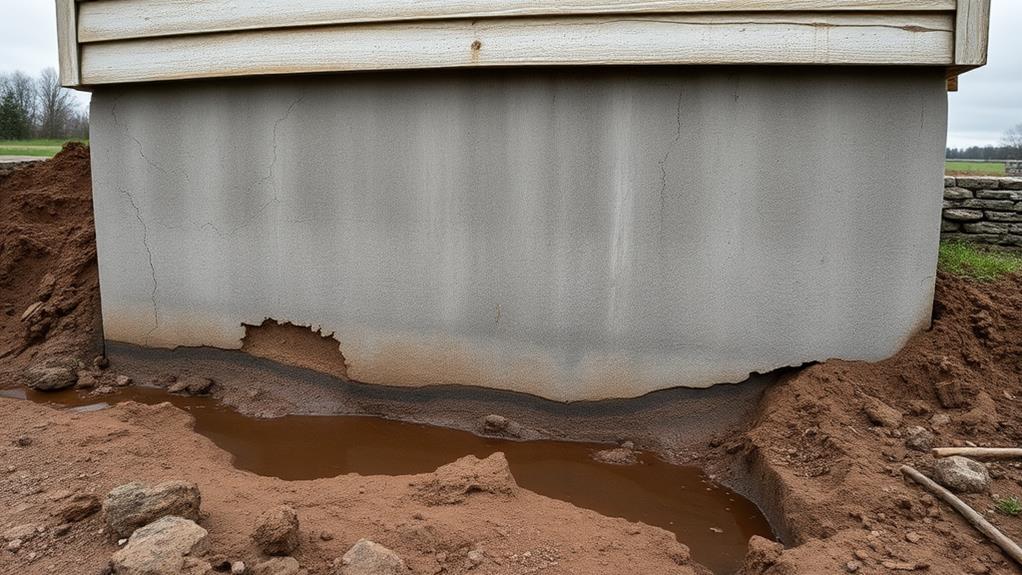Post-storm foundation issues can manifest as visible cracks, leaks, and structural shifts. Key red flags include cracks in foundation walls, uneven floors, sticking doors and windows, and water seepage in lower levels. Exterior wall rotation, sagging walls, and chimney separation are serious indicators of foundation damage. Soil erosion around the foundation and mold growth in basements can also signal underlying problems. These issues often result from water infiltration, hydrostatic pressure, or soil instability caused by severe weather. Prompt identification and professional assessment of these warning signs are crucial to prevent further structural damage and ensure your home's long-term stability.
Visible Cracks in Foundation Walls

After a severe storm, visible cracks in foundation walls serve as crucial indicators of potential structural damage. These cracks can vary in size, shape, and orientation, each potentially signifying different underlying issues. Hairline cracks, while common, may indicate minor settling or shrinkage. However, wider cracks, particularly those exceeding 1/4 inch, warrant immediate attention as they could suggest more severe structural problems.
Horizontal cracks are especially concerning, often resulting from hydrostatic pressure or soil movement. They may indicate compromised structural integrity and require prompt professional assessment. Vertical cracks, while generally less alarming, can still point to foundation settling or soil expansion. Diagonal cracks frequently stem from uneven settling and may signify issues with soil stability or drainage.
Post-storm foundation cracks can also manifest as stair-step patterns in brick or concrete block walls, typically caused by foundation movement or soil instability. It's essential to document all observed cracks, noting their location, size, and any changes over time. Professional evaluation is crucial to determine the extent of damage and necessary remediation steps, ensuring the long-term stability and safety of the structure.
Uneven or Sloping Floors
A telltale sign of post-storm foundation issues, uneven or sloping floors can indicate significant structural problems. These irregularities often result from foundation settling, shifting, or heaving due to water damage or soil erosion caused by severe weather events.
Homeowners may notice doors that no longer close properly, gaps between walls and floors, or a distinct tilt when walking across rooms.
To identify uneven floors, conduct a simple test using a level or rolling a marble across the surface. If the marble consistently rolls in one direction or the level shows a noticeable discrepancy, further investigation is warranted. Pay close attention to areas near load-bearing walls and corners, as these are prone to movement during foundation stress.
Addressing uneven floors promptly is crucial to prevent further damage. Potential remedies include foundation leveling, pier and beam adjustments, or slab jacking, depending on the severity and underlying cause. However, it's essential to consult with a professional structural engineer or foundation specialist to accurately diagnose the issue and recommend appropriate repairs.
Ignoring sloping floors can lead to more severe structural problems, compromising the integrity and safety of the entire building.
Sticking Doors and Windows

Frustration often mounts when homeowners encounter sticking doors and windows following a severe storm. While this issue may seem like a minor annoyance, it can actually indicate serious foundation problems. As the ground settles or shifts due to excessive moisture or erosion, the home's structure can become misaligned, causing door frames and window openings to warp.
Pay close attention to doors and windows that suddenly become difficult to open or close smoothly. Look for visible gaps between the door or window and its frame, especially if they appear uneven or wider at the top or bottom. These issues may be accompanied by cracking in the surrounding walls or ceilings. In multi-story homes, check if the problem is more pronounced on upper floors, as this could suggest a shifting foundation below.
It's important to note that some sticking can occur due to humidity-induced swelling in wooden frames. However, if the problem persists after weather conditions normalize or affects multiple openings throughout the house, it's crucial to have a professional foundation inspection. Early detection and intervention can prevent more extensive and costly damage to your home's structural integrity.
Water Seepage or Dampness
Frequently overlooked, water seepage or dampness in a home's lower levels can be a telltale sign of foundation issues following a severe storm. These moisture problems often manifest as wet spots on walls, floors, or ceilings, musty odors, or visible mold growth. In the aftermath of heavy rainfall or flooding, water can penetrate through cracks or gaps in the foundation, leading to ongoing seepage issues.
Homeowners should be vigilant in inspecting their basements, crawl spaces, and ground-level rooms for signs of moisture intrusion. Pay particular attention to corners, areas around windows, and where walls meet the floor. The presence of efflorescence, a white, powdery substance on concrete or brick surfaces, indicates water has moved through the material, leaving behind mineral deposits. Additionally, warped or buckled flooring, peeling paint, or deteriorating baseboards can all point to underlying moisture problems.
It's crucial to address water seepage promptly, as persistent dampness can lead to structural damage, compromise indoor air quality, and create an environment conducive to mold growth. If you suspect foundation-related water issues, consult a professional to assess the severity and recommend appropriate remediation measures.
Exterior Wall Rotation

Beyond visible cracks and water damage, exterior wall rotation is a critical yet often overlooked sign of foundation problems following severe storms. This phenomenon occurs when foundation movement causes walls to tilt outward or inward, compromising the structural integrity of the building. Homeowners should be vigilant for signs of wall rotation, including doors and windows that no longer close properly, gaps between walls and ceilings, or visibly tilted walls when viewed from the exterior.
To detect wall rotation, use a level to check the verticality of exterior walls, paying close attention to corners and areas near windows and doors. Measure the angle of deviation from true vertical, as even slight rotations can indicate significant foundation issues. Soil saturation from heavy rainfall or flooding can exacerbate this problem by causing differential settlement or lateral pressure on foundation walls.
If left unaddressed, wall rotation can lead to more severe structural damage, including roof collapse or complete wall failure. Professional assessment is crucial if wall rotation is suspected, as remediation often requires specialized techniques such as underpinning, helical piers, or soil stabilization to prevent further movement and restore structural stability.
Gaps Around Windows or Doors
A telltale sign of post-storm foundation issues, gaps around windows or doors can indicate significant structural problems. These gaps often result from shifting foundations, causing misalignment in the building's structure.
As the foundation settles unevenly, it can lead to distortion in door and window frames, creating visible spaces between the frame and the surrounding wall.
Homeowners should carefully inspect the perimeter of windows and doors for any unusual openings or spaces. Pay particular attention to areas where daylight is visible through gaps, as this suggests a more severe separation.
Doors that suddenly become difficult to open or close, or windows that no longer lock properly, may also signal foundation movement.
These gaps not only compromise the structural integrity of the building but can also lead to energy inefficiency, moisture intrusion, and pest infiltration. Prompt identification and professional assessment of these issues are crucial to prevent further damage.
Foundation experts can determine whether the gaps are caused by normal settling or more serious foundation problems, and recommend appropriate repair strategies such as foundation leveling, wall anchoring, or structural reinforcement.
Sagging or Bowing Walls

Sagging or bowing walls often emerge as critical indicators of foundation damage following severe storms. These structural deformities typically result from excessive hydrostatic pressure, soil erosion, or water infiltration, which can compromise the foundation's integrity. As the foundation settles unevenly or shifts, walls may begin to lean inward or outward, creating visible distortions in their alignment.
To identify sagging or bowing walls, homeowners should conduct a thorough visual inspection both inside and outside the property. Look for horizontal or diagonal cracks along the walls, particularly near the corners or at the junction of walls and ceilings. Use a level tool to check for any deviations from plumb, paying close attention to long, uninterrupted wall sections. In basements, measure the wall's curvature at its most pronounced point to gauge the severity of the bowing.
If sagging or bowing walls are detected, it is crucial to consult a professional foundation specialist immediately. These experts can assess the extent of the damage, determine the underlying causes, and recommend appropriate remediation strategies, such as installing wall anchors, carbon fiber strips, or implementing more extensive foundation repair methods.
Chimney Separation From House
Vigilant homeowners should be aware that chimney separation from the house is a significant post-storm foundation red flag. This issue occurs when the chimney begins to pull away from the main structure, creating a visible gap between the two. Severe weather events, such as hurricanes or tornadoes, can exacerbate existing foundation problems or create new ones, leading to this separation.
The separation typically starts at the roofline and may extend downward. Signs include cracks in the exterior walls near the chimney, a tilting chimney, or gaps between the chimney and the house siding. This problem not only compromises the structural integrity of the home but also poses safety risks, as it can allow water infiltration, pest intrusion, and potential chimney collapse.
If chimney separation is observed, immediate professional assessment is crucial. A structural engineer or foundation specialist can determine the underlying cause and recommend appropriate repairs. Solutions may include underpinning the foundation, installing support beams, or in severe cases, rebuilding the chimney. Timely intervention is essential to prevent further damage and ensure the safety of the home's occupants.
Soil Erosion Around Foundation

Significant soil erosion around the foundation is another critical post-storm indicator of potential structural issues. Heavy rainfall and flooding can wash away soil supporting the foundation, creating voids and compromising the structure's stability. This erosion may manifest as visible gaps between the soil and foundation walls, exposed footings, or uneven settling of the building.
Pay close attention to areas where water tends to pool or flow during storms, as these are most susceptible to erosion. Look for signs of soil displacement, such as mounds of dirt or sediment accumulation near downspouts or at the base of the foundation. Inspect the grading around the house, ensuring it slopes away from the foundation to promote proper drainage.
If soil erosion is detected, immediate action is necessary to prevent further damage. This may involve regrading the surrounding landscape, installing proper drainage systems, or reinforcing the foundation with additional support. In severe cases, professional assessment and repair may be required to address underlying structural issues caused by soil erosion and to ensure the long-term stability of the building.
Mold Growth in Basement
After a storm, how quickly can mold become a problem in your basement? Mold can start growing within 24 to 48 hours of moisture exposure, making it a critical concern following severe weather events. Basements, being naturally prone to dampness and flooding, are particularly susceptible to mold growth after storms.
Signs of mold growth include visible discoloration on walls, floors, or ceilings, often appearing as black, green, or white patches. A musty odor is another telltale indicator of mold presence. Look for water stains, peeling paint, or warped materials, as these can suggest underlying moisture issues conducive to mold growth.
To address mold growth, first identify and resolve the source of moisture. This may involve repairing leaks, improving drainage, or using dehumidifiers. Remove standing water and dry affected areas thoroughly. For small areas of mold (less than 10 square feet), careful cleaning with appropriate solutions may suffice. However, extensive mold growth often requires professional remediation to ensure complete removal and prevent health risks. Regular inspections and prompt action after storms are crucial in preventing widespread mold problems in your basement.
Frequently Asked Questions
How Much Does Foundation Repair Typically Cost After Storm Damage?
Foundation repair costs after storm damage typically range from $2,000 to $20,000, depending on the extent of damage and necessary repairs. Factors influencing cost include foundation type, repair method, and local labor rates.
Can I Claim Foundation Damage on My Homeowner's Insurance Policy?
Generally, homeowner's insurance may cover foundation damage caused by sudden, accidental events like storms. However, coverage varies by policy and circumstances. Review your specific policy or consult your insurance agent for details on potential claim eligibility.
How Long Does a Professional Foundation Inspection Usually Take?
Ah, the joys of watching paint dry! A professional foundation inspection typically takes 2-3 hours, depending on the home's size and complexity. Inspectors meticulously examine the structure, looking for signs of damage or potential issues.
Are There DIY Solutions for Minor Post-Storm Foundation Issues?
While some minor post-storm foundation issues can be addressed with DIY solutions, it's crucial to exercise caution. Simple fixes may include improving drainage, sealing small cracks, or adjusting gutters. However, professional assessment is recommended for long-term safety and effectiveness.
How Often Should I Have My Foundation Inspected After Severe Weather Events?
Like Noah inspecting the ark after the flood, homeowners should assess their foundation post-severe weather. Experts recommend inspections after each major event, or at least annually. Regular checks can prevent minor issues from becoming costly problems.
Conclusion
Foundation damage following storms can manifest in various ways, from visible cracks to subtle shifts. Recognizing these signs early is crucial for homeowners and professionals alike. By monitoring for uneven floors, sticking doors, water seepage, wall rotation, and chimney separation, potential issues can be identified and addressed promptly. Regular inspections, particularly after severe weather events, can prevent minor problems from escalating into major structural concerns. Vigilance, expertise, and timely intervention are key to maintaining a safe and stable foundation.

